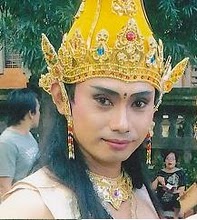Dhian Lestari Hastuti, S.Sn., M.Sn, is a lecturer of design interior at Indonesis Arts Institute, Surakarta, Indonesia, and Executive Director of Djawa Trails, an heritage organization based in Solo. Besides her research activities, she likes to participate in heritage activities as well in Solo city.
Agung PW:
Your postgraduate’s thesis entitled 'Ndalem Interior at Batik Laweyan Houses’ Merchant in Early 20th-Century, An Aesthetics Studies', is quite interesting. What is your background to choose the case?
Dhian Lestari Hastuti:
The background to the study of aesthetics of ndalem interior in houses of Laweyan campong’s merchants, because dalem for Laweyan people in the early 20-th century was one of several of self-identification as a marginalized cultural communities. The beauty of value housing philosophy, particularly ndalem for Laweyan batik merchants were life meaning they believed.



